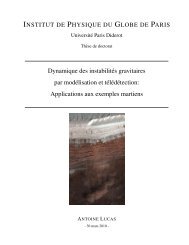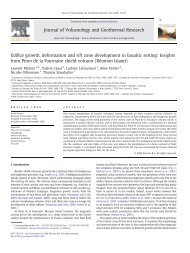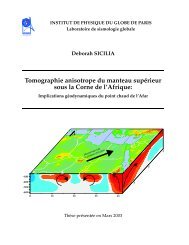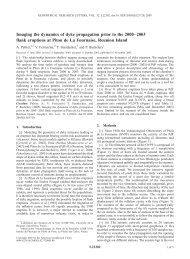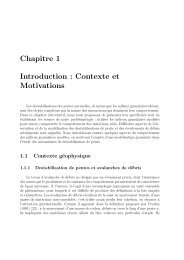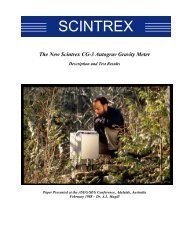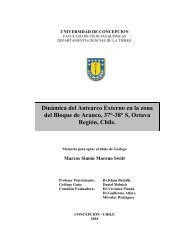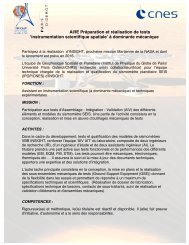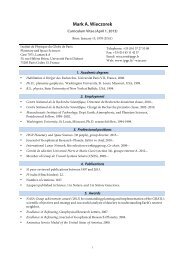Tectonics Lab. – Institut de Physique du Globe de Paris (IPGP)
Tectonics Lab. – Institut de Physique du Globe de Paris (IPGP)
Tectonics Lab. – Institut de Physique du Globe de Paris (IPGP)
Create successful ePaper yourself
Turn your PDF publications into a flip-book with our unique Google optimized e-Paper software.
<strong>Tectonics</strong> <strong>Lab</strong>. <strong>–</strong> <strong>Institut</strong> <strong>de</strong> <strong>Physique</strong> <strong>du</strong> <strong>Globe</strong> <strong>de</strong> <strong>Paris</strong> (<strong>IPGP</strong>)<br />
Preliminary evaluation of the Haiti January 12, 2010, earthquake<br />
(at the date of Jan 25, 2010)<br />
R. Lacassin, Y. Klinger, N. Feuillet, R. Armijo, P. Tapponnier*<br />
Tectonique, <strong>IPGP</strong>, 4 place Jussieu, 75252 paris CX 05, France<br />
lacassin@ipgp.jussieu.fr<br />
* presently at EOS, NTU Singapore<br />
Tectonic and seismotectonic context :<br />
The Haiti earthquake of 2010 January 12 (21h53 UTC) occurred on the boundary between the Caribbean<br />
and North American plates (Figure 1). Its magnitu<strong>de</strong> (Mw) has been estimated to 7.0 (USGS), 7.1 (EMSC), 7.2<br />
(french CEA). About 20 mm/yr of relative motion occurs in an 070°E direction along this relatively complex<br />
plate-boundary [1, 2]. In Haiti, located in the western part of Hispaniola island, the oblique plate relative motion<br />
is partitioned between left-lateral strike-slip movement on roughly E-W faults and N-S to NNE-SSW shortening<br />
which pro<strong>du</strong>ces thrusts and folds across the island and along its northern and southern coastal margins (Figure<br />
1).<br />
Figure 1 : Plate tectonic context of the Jan 12, 2010 earthquake in Haiti. Map after [1].<br />
Two main active faults absorb the left-lateral component of motion : the Septentrional Fault in N Haiti and<br />
Dominican Republic, the Enriquillo Fault in SW Haiti. GPS measurements and mo<strong>de</strong>ling suggest that each of<br />
these faults are fully coupled, each one with slip a rate of ~7-8 mm/yr [2]. The location of the main shock<br />
hypocenter and its mechanism (sources : USGS, EMSC, Harvard), the E-W distribution of aftershocks (Figure 2)
suggest that the Jan. 12 earthquake ruptured a ~50km long segment of the Enriquillo fault SW of Port au Prince.<br />
Historical [3] and instrumental data indicates that the Enriquillo fault has not pro<strong>du</strong>ced a major earthquake<br />
since the past couple of centuries. A sequence of 3 <strong>de</strong>structive events occurred in southern Hipaniola in the 18 th<br />
century; some of them are possibly associated with the Enriquillo fault [2, 4]. The sequence started with a large<br />
earthquake on October 18 th 1751, which caused significant <strong>de</strong>struction and a tsunami in the gulf of Azua (in<br />
southern Dominican Republic). This earthquake is generally associated with rupture of the Muertos thrust belt<br />
offshore SE Hispaniola. On November 21 th 1751, a strong earthquake <strong>de</strong>stroyed Port Au Prince, a town which<br />
had been foun<strong>de</strong>d 2 years before (Port au Prince will become the capital of the french colony of Saint-Domingue<br />
in 1770, then of Haiti in 1804). Destructions mainly occurred along the Cul <strong>de</strong>-Sac plain to the E of the city. This<br />
earthquake may have ruptured a part of the Enriquillo Fault SE of Port au Prince, although the hypothesis of a<br />
thrust rupture on some other fault is equally tenable. On June 3 th 1770, a major earthquake <strong>de</strong>stroyed again Port<br />
Au Prince as well as towns west of this city (Léogâne, Petit Goâve, Miragoâne). It is likely that this event has<br />
occurred on the Enriquillo fault south and SW of Port au Prince. Finally, on April 8 th 1860, a major earthquake<br />
affected the western end of the Tiburon peninsula and was associated with a tsunami. The effects of the Jan 12,<br />
2010 earthquake appear similar to those of the June 21 th 1770 event<br />
The Enriquillo fault trace <strong>–</strong> Hypothetic location of the rupture :<br />
From the SW of Port au Prince to Tiburon at the western end of the peninsula, the Enriquillo fault trace is<br />
segmented by several structural complexities such as changes in strike; pull-apart and push-up structures in<br />
releasing or restraining bends (Figure 3 and [4]). From west to east, the major complexities are : the Pic Macaya<br />
push-up (high relief there is <strong>du</strong>e to thrusting associated with the restraining bend), the Clonard pull-apart, the<br />
Figure 2 : Sketch map of active fault traces along the Enriquillo fault zone. Location of Jan 12 main shock and<br />
aftershocks from USGS. The coseismic rupture probably propagated from the epicenter region towards the W,<br />
ending at the Mirogoâne lakes intersegment. Map in part after [4].
Miragoâne Lakes pull-apart zone [4]. The latter zone, relatively complex, shows several pull-apart basins partly<br />
shortcut by the more recent active fault traces. It is limited to the E by the small (~8km long) Provence push-up,<br />
boun<strong>de</strong>d by two main active fault traces, one, offshore, to the north, the other, onshore, south of Petit Goâve and<br />
Grand Goâve. South of Port au Prince, near Pétionville, the fault slightly changes in strike and becomes<br />
transpressive to the E, possibly <strong>de</strong>fining another inter-segment. The average, first-or<strong>de</strong>r, segment length is 40-60<br />
km. Preliminary interpretation of InSAR data suggest that the Jan. 12 rupture stopped in the region of the<br />
Miragoâne pull-apart zone, possibly on the Provence push-up, which probably acted as a barrier for rupture<br />
propagation (Figure 2).<br />
About 50 aftershocks with M > 4 have been recor<strong>de</strong>d within the first 8 days after the main Jan. 12 shock<br />
with largest magnitu<strong>de</strong>s reaching Mw~6. Aftershocks cluster in two distinct areas (USGS locations) : one around<br />
the hypocenter; the other, with more events, close to Petit Goâve and to the stepover of the Enriquillo fault in the<br />
Miragoâne plain (Figure 2). So, most of the aftershock activity appears to occur near the western rupture end, a<br />
region where the probability of failure may have been increased by static Coulomb stress change (as observed<br />
for other earthquakes elsewhere, i.e. Joshua Tree, 1992 M6.1, and Lan<strong>de</strong>rs, 1992 M7.4, earthquakes [5]).<br />
First results obtained on the seismic data [6] suggest a burst in moment release <strong>du</strong>ring the first 10s of the<br />
signal and little evi<strong>de</strong>nce for rupture propagation. This could suggests that the main rupture was concentrated on<br />
a relatively short segment of the fault (a few tens of km in length).<br />
We searched for evi<strong>de</strong>nce of coseismic surface breaks along fault traces on Hi-Res satellite images that<br />
have been acquired after the Jan. 12 event (SPOT5, ALOS, GeoEye images). Most of the fault trace length lacks<br />
clear evi<strong>de</strong>nce of such breaks on the images publicly available at the date of Jan. 25 (high quality post-<br />
Figure 3a : Possible traces of a coseismic surface break<br />
south of Léogâne (GeoEye images, available from Google<br />
Earth).
earthquake images are still lacking W of Grand Goâve), although lateral spreading associated with shallow<br />
landsli<strong>de</strong>s is clearly visible on these images. This probably means that surface ruptures, if they exist, are not<br />
<strong>de</strong>tectable given the resolution of the images (submetric in Geoeye images). It implies that surface offsets<br />
associated with the earthquake rupture were less than ~1m. For example, in the valleys of Rivière Momance and<br />
Rivière Froi<strong>de</strong>, SSW of Carrefour, the active fault trace is clearly marked by cumulative scarps and geomorphic<br />
offsets at several places (e.g., at 72°25.64’W -18°28.68’N, or, close to the epicenter, at<br />
72°32.25‘W-18°28.68’N). Unambiguous evi<strong>de</strong>nce for recent fault reactivation are lacking at these sites.<br />
However, we have i<strong>de</strong>ntified few subtle pieces of evi<strong>de</strong>nce indicating possible surface breaks (
satellite (in the line of sight, or LOS, direction), which may be interpreted as the western termination of the left<br />
lateral rupture (Figure 4). From these data, the exact location of the ruptured fault west of Grand Goâve is<br />
difficult to assess. If the interpretation represented on Figure 4 is correct, it might be onshore, on the fault<br />
bounding the Provence push-up to the south. From the continuity of the lobes of fringes on both si<strong>de</strong>s of the this<br />
fault, we infer that the rupture likely remained blind at its western end. At the date of Jan. 25, as comparable data<br />
are lacking towards the E, we cannot assess the eastern end of the ruptured segment.<br />
Figure 4 : Tentative interpretation of the Alos interferogram.<br />
Preliminary conclusions :<br />
The 2010 January 12 earthquake broke a segment of the left-lateral Enriquillo fault, a fault that would<br />
account for a significant (~7mm/yr [2]) fraction of the motion between Caribbean and N-American plates. W of<br />
Haiti the Enriquillo fault prolongates offshore towards Jamaica where it becomes the Plantain gar<strong>de</strong>n Fault. The<br />
Enriquillo fault, which stretches for ~300km across southern Hispaniola island, was already i<strong>de</strong>ntified as a<br />
potential source of M>7 earthquakes [2]. Before the 2010 event, this fault had not pro<strong>du</strong>ced significant<br />
earthquakes since at least two centuries. At least one event (June 3 th 1770) of the sequence that shook southern<br />
Hispaniola in the 18th century, likely occurred on the Enriquillo fault, with reported effects resembling those of<br />
the 2010 event. Only a relatively short segment of the fault (~30km, possibly 50km, Figure 2) seems to have
een activated by the January 12 event. Large earthquakes on long-quiescent, strike-slip fault zones tend to<br />
trigger one another, thus pro<strong>du</strong>cing sequences of <strong>de</strong>structive events like those well documented on the North<br />
Anatolian Fault in Turkey. We thus infer that the rupture of segments east of the Jan. 12 source (immediately SE<br />
of Port au Prince) and west of it (across Tiburon peninsula) is likely to occur in the coming <strong>de</strong>ca<strong>de</strong>s.<br />
At the date we are writing (Jan. 25th), conclusive evi<strong>de</strong>nce to constrain the exact length of the ruptured<br />
segment, the location of surface breaks (if any) and the amount of coseismic slip at the surface, are lacking.<br />
However, first InSAR results may help to <strong>de</strong>fine the western end of the rupture, which apparently stopped in the<br />
region east of the Miragoâne lakes pull-apart. The lack of clear coseismic surface break and measurable offsets<br />
along the fault on available post-earthquake high-res imagery suggests that slip at the surface has been less than<br />
0.5<strong>–</strong>1m and/or is distributed across a large zone. New constraints on the <strong>de</strong>formation field (in particular InSAR<br />
interferograms covering the eastern part of the rupture, and GPS measurements), higher resolution imagery<br />
(aerial photographs, topography acquired with Lidar, for instance), and field survey are clearly nee<strong>de</strong>d. Finally,<br />
the lack of geomorphic studies and of paleoseismological trenching along the Enriquillo fault implies that its<br />
average rate is not known at geological time-scales, neither is its seismic history precisely established.<br />
_____________<br />
Short bibliography - Useful links :<br />
[1] Feuillet N., Sismotectonique <strong>de</strong>s Petites Antilles. Liaison entre activité sismique et volcanique, thèse, Univ.<br />
<strong>Paris</strong> VII-Denis Di<strong>de</strong>rot Univ., France, 2000 <strong>–</strong> Feuillet et al., Arc parallel extension and localization of volcanic<br />
complexes in Gua<strong>de</strong>loupe, Lesser Antilles, J. Geophys. Res (2002), doi:10.1029/2001JB000308.<br />
[2] Mann, P., E. Calais, J. C. Ruegg, C. DeMets, P. E. Jansma, and G. S. Mattioli, Oblique collision in the<br />
northeastern Caribbean from GPS measurements and geological observations, <strong>Tectonics</strong>, 21, 1057, 2002.<br />
Manaker et al., Interseismic plate coupling and strain partitioning in the northeastern Caribbean, Geophys. J. Int.<br />
(2008) 174, 889-903.<br />
[3] Moreau <strong>de</strong> Saint Méry, Description topographique, physique, civile, politique et historique <strong>de</strong> la partie<br />
française <strong>de</strong> l’isle Saint Domingue, T2, 1798, online : http://gallica.bnf.fr/ark:/12148/bpt6k111180r <strong>–</strong> Scherer,<br />
J.C., Great earthquakes in the island of Haiti, Bull. Seism. Soc. Am., 2, 161-180, 1912 <strong>–</strong> O’Loughlin, K.F. and<br />
Lan<strong>de</strong>r, J.F., Caribbean Tsunamis, A 500-year history from 1498-1998, Adv. in Natural and Technological<br />
Hazards Research, Kluwer.<br />
[4] Mann, P., F. W. Taylor, R. L. Edwards, and T.-L. Ku, Actively evolving microplate formation by oblique<br />
collision and si<strong>de</strong>ways motion along strike-slip faults: An example from the northeastern Caribbean plate<br />
margin, Tectonophysics, 246, 1-69, 199.
[5] King, G.C.P., R.S. Stein, and Jian Lin, Static stress changes and the triggering of earthquakes, Bull. Seismol.<br />
Soc. Am. 84, 3, pp. 935-953, 1994.<br />
[6] Gavin Gayes (NEIC-USGS) mo<strong>de</strong>l http://earthquake.usgs.gov/earthquakes/eqinthenews/2010/us2010rja6/<br />
finite_fault.php <strong>–</strong> Martin Vallée (Geoazur, Univ. Nice) mo<strong>de</strong>l http://geoazur.oca.eu/spip.php?article614 <strong>–</strong><br />
Anthony Sla<strong>de</strong>n (Caltech) mo<strong>de</strong>l http://tectonics.caltech.e<strong>du</strong>/slip_history/2010_haiti/<br />
[7] Correlogram of TerraSAR-X data : http://www.zki.dlr.<strong>de</strong>/applications/2010/haiti/182_en.html and DLR's<br />
report (in PDF format)<br />
[8] First ALOS interferogram from JAXA : http://www.eorc.jaxa.jp/ALOS/img_up/jdis_pal_haiti_100116.htm.<br />
See also http://www.eorc.jaxa.jp/ALOS/en/img_up/dis_pal_haiti_100116.htm<br />
Some usefull web pages :<br />
- <strong>IPGP</strong> : http://www.ipgp.fr/pages/040114.php<br />
- Geoazur, Nice : http://geoazur.oca.eu/spip.php?article614<br />
- EMSC : http://www.emsc-csem.org/in<strong>de</strong>x.php?page=current&sub=recent&evt=151256<br />
- CEA/DASE : http://www-dase.cea.fr/actu/dossiers_scientifiques/2010-01-13/in<strong>de</strong>x.html<br />
- CNRS/INSU : http://www.insu.cnrs.fr/a3348,seisme-haiti-12-janvier-2010.html<br />
- Eric Calais - Pur<strong>du</strong>e University : http://web.ics.pur<strong>du</strong>e.e<strong>du</strong>/~ecalais/haiti/<br />
- Univ. of Texas Austin (Paul Mann) : http://www.jsg.utexas.e<strong>du</strong>/news/rels/011310.html
Figure 1 : Plate tectonic context of the Jan 12, 2010 earthquake in Haiti. Map after [1].
Figure 2 : Sketch map of active fault trace along the Enriquillo fault zone across the Tiburon peninsula.<br />
Location of Jan 12 main shock and aftershocks from USGS. The coseismic rupture probably<br />
propagated from the epicenter region towards the W, ending at the Mirogoâne lakes intersegment. Map<br />
in part after [4].
Figure 3a : Possible traces of a coseismic surface break south of Léogâne (GeoEye<br />
images, available from Google Earth).
Figure 3b : The Enriquillo fault trace in the Rivière Momance valley (GeoEye images)



